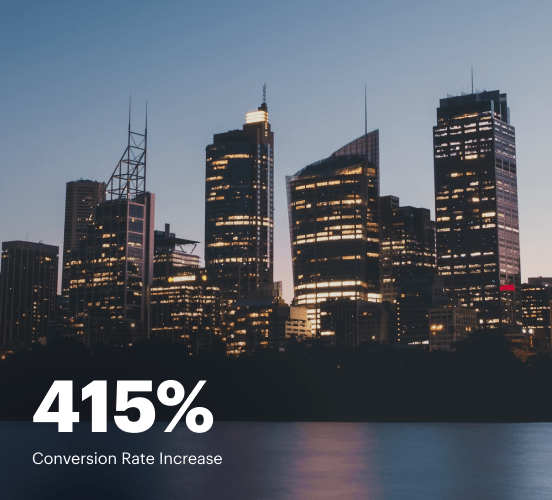How WordPress vs. Adobe Target vs. Instapage stack up against each other
Compare Instapage with WordPress and Adobe Target to create high-converting landing pages. With personalization, optimization, and collaboration tools, Instapage helps you deliver experiences that drive results.
Get startedSee how Instapage stacks up against the competition
| Feature | Instapage | Other builders |
| Drag-and-Drop Tools | ||
| Conversion-optimized templates | ||
| Manual and AI-powered A/B Tests | ||
| AI content suggestions | ||
| Popups and sticky bars | ||
| Canvas and grid blocks | ||
| Reusable and global elements | ||
| Form and popup builders | ||
| Built-in Heatmaps | ||
| Central analytics dashboard | ||
| Ad-to-page personalization and collections | ||
| Contacts, lists, and email | ||
| Dedicated, full-service CRO experts | ||
| Enterprise-ready platform |
Leading the way in building high-performing landing pages





Why Instapage is the smarter choice for your campaigns
Get everything you need to build, scale, and optimize high-converting landing pages—without coding.

Easier page building without coding
Instapage offers a flexible and seamless page creation experience with a library of 500+ conversion-focused layouts, Instablocks®, a drag-and-drop builder, and AI content generation. With technologies like Thor Render Engine®, you can create on-brand, mobile-responsive landing pages that load quickly and start converting during initial visitor clicks.

More insights — better results
Instapage lets you see in detail how each landing page experience and variation is performing so you can make targeted changes that boost page conversions. Use heatmaps for a better understanding of on-page activities, run A/B tests and AI-assisted experiments, and then track and evaluate results within robust analytics dashboards.

More personalized experiences
Instapage lets you quickly create high-performing landing pages tailored to each of your ad campaigns. Deliver personalized experiences for distinct audiences using dynamic text replacement. Effortlessly align specific advertisements to unique pages with AdMaps. Monitor audience-level metrics using our advanced data tools.

Built-in collaboration
Instapage collaboration capabilities bring your entire team together to speed up the process of landing page review, approval, and launch. No more frustrating and unnecessary revisions or edits scattered across emails. Provide instant feedback, conduct real-time page edits, and securely share your pages with outside stakeholders.

Free up time for your business
Invest time into business growth, not busy work. Launch landing pages faster with reusable forms and templates. Build once, reuse forever.
Explore all integrations






Easier page building without coding
Instapage offers a flexible and seamless page creation experience with a library of 500+ conversion-focused layouts, Instablocks®, a drag-and-drop builder, and AI content generation. With technologies like Thor Render Engine®, you can create on-brand, mobile-responsive landing pages that load quickly and start converting during initial visitor clicks.
More insights — better results
Instapage lets you see in detail how each landing page experience and variation is performing so you can make targeted changes that boost page conversions. Use heatmaps for a better understanding of on-page activities, run A/B tests and AI-assisted experiments, and then track and evaluate results within robust analytics dashboards.
More personalized experiences
Instapage lets you quickly create high-performing landing pages tailored to each of your ad campaigns. Deliver personalized experiences for distinct audiences using dynamic text replacement. Effortlessly align specific advertisements to unique pages with AdMaps. Monitor audience-level metrics using our advanced data tools.
Built-in collaboration
Instapage collaboration capabilities bring your entire team together to speed up the process of landing page review, approval, and launch. No more frustrating and unnecessary revisions or edits scattered across emails. Provide instant feedback, conduct real-time page edits, and securely share your pages with outside stakeholders.
Free up time for your business
Invest time into business growth, not busy work. Launch landing pages faster with reusable forms and templates. Build once, reuse forever.
Explore all integrationsGet started with Instapage in a few steps
-
Create your Instapage account
Start with Instapage by signing up via Google or your email. You'll get access to a free 14-day trial to discover Instapage capabilities. Feel free to cancel anytime during the 14-day trial if you decide that our product is not suitable for your business. -
Build and personalize your page
Create your first landing page from scratch or choose a template from 500+ customizable layouts. Use the drag-and-drop builder to add page elements, fonts, and backgrounds, refine content with AI, or add custom HTML, Javascript, and CSS. -
Review and make edits
Collaborate on page designs and streamline review processes. Invite your team members and stakeholders to review, edit, and provide feedback on your landing page. Collaborate knowing your page is confidential and only accessible to authorized users. -
Publish and track page performance
Publish your page to a domain or custom URL. Connect your pages to the ads you've created and track page performance within the analytics dashboard, run A/B tests and AI experiments, analyze results, and continuously optimize your landing page to maintain high conversions.
Instapage, WordPress, and Adobe Target – The Showdown Begins!
Choosing the right landing page builder can feel like assembling an all-star team of superheroes for your marketing campaign. Each option comes with its own set of powers and capabilities, ready to tackle different challenges you might face in the digital space. Whether you need speed, customization, or support, aligning your business goals with the right tool is essential for triumphant conversions. In this article, we pit Instapage against WordPress and Adobe Target to help you discover which platform might just be your marketing superhero. Get ready for an exciting journey where we explore the strengths and weaknesses of these three contenders, comparing features, performance, usability, and pricing to find the best fit for your needs. With Instapage’s promise to help marketers reduce costs, grow conversions, and deliver tailored landing page experiences that build brand trust and loyalty, we’ll see why it stands out from the crowd.
Meet the Contenders: Who's Who in the Digital Arena
In this corner, we have Instapage, a platform specializing in creating high-converting landing pages with unmatched customization capabilities. It's like having a dedicated sidekick that focuses solely on ensuring your marketing messages are on-brand and perfect for your audience. Next up is WordPress, an incredibly versatile content management system (CMS) that's more than just a blogging platform; with the right plugins and themes, it can accommodate a range of landing page designs. Finally, we have Adobe Target, a powerful tool known for its personalization features and A/B testing capabilities, allowing marketers to fine-tune their strategies based on user behavior. While they each boast unique strengths, they all aim to help marketers craft effective landing pages that drive results. In this competitive landscape, the winner will depend on specific business needs and goals.
Round One - Feature Comparison Extravaganza
Diving into Template Variety and User-Friendliness
When it comes to template offerings and ease of use, each of the three platforms takes a different approach. Instapage shines with its vast library of professionally designed, customizable templates that cater to various industries and campaigns. Users can easily modify designs using a drag-and-drop interface, making it accessible even for those without coding skills. On the flip side, WordPress requires users to install landing page plugins like Elementor or Beaver Builder, which can enhance its capabilities significantly. While this offers flexibility, there can be a learning curve involved in getting everything up and running seamlessly. Adobe Target, while robust in its features, is focused more on targeting and personalization rather than offering a plethora of templates. Thus, while it provides excellent support for dynamic content delivery, it might not offer as many customizable templates out-of-the-box as Instapage. In terms of usability, Instapage tends to be simplest, especially for marketers who want to get started right away without wrestling with technical details.
Instapage: Your Partner in Customization and Boosting Conversions
Instapage stands tall as a leading tool when it comes to customization options. With features like easy-to-manage A/B testing, extensive analytics, and personalized content layers, Instapage doesn’t just provide a landing page builder; it offers a comprehensive solution for optimization and enhancement. Marketers can tweak their landing pages based on real-time insights to boost conversion rates significantly. This level of adaptability allows brands to deliver relevant experiences tailored to individual user preferences—thereby increasing trust and loyalty among customers. Additionally, Instapage offers collaboration tools that facilitate seamless teamwork among marketing staff, making campaigns more efficient. When considering conversion rate optimization, it truly stands out as a powerful ally in achieving distinct business objectives.
Round Two - Speed and Performance Showdown
In the age of instant gratification, speed is crucial. Think of the frustration of waiting in line at a busy coffee shop with only a few minutes to spare—slow landing pages can evoke those same frustrations for users. A fast-loading landing page not only creates a positive first impression but significantly influences user engagement and conversions. The anticipation of a quick and responsive experience keeps users interested and reduces bounce rates. Now, let’s explore how each platform fares in terms of speed and overall performance.
Advantages of Instapage:
- Built-in AMP support for faster loading times.
- Offers advanced caching options for optimal performance.
- Utilizes a Content Delivery Network (CDN) to improve access speed.
- Mobile responsiveness ensures quick load times on all devices.
Advantages of WordPress:
- Can leverage caching plugins to enhance loading speeds.
- Customization of themes can improve performance if done correctly.
- Hosting providers can impact speed; many offer optimized servers for better performance.
Advantages of Adobe Target:
- Robust adaptive content technology reduces unnecessary load times.
- Personalization algorithms optimize content delivery for faster user reactions.
- Integration into existing infrastructure can ensure efficient resource management.
Overall, speed can be enhanced by all platforms through smart configurations or proper usage of tools and protocols. However, Instapage holds an edge with built-in features designed specifically for landing page optimization, making it the best performer in this key aspect.
Round Three - Usability and User Experience Insights
Navigating a new platform can sometimes be daunting, but all three options cater either to newcomers or seasoned veterans. Instapage focuses on providing an intuitive interface, making it easier for even the least technical marketers to create compelling landing pages without extensive preparation. The platform offers guided tours and tutorials to ease the onboarding process. WordPress's flexibility means that users have the potential to create something extraordinary, but also may require a higher level of skill—especially with the necessary plugins involved. Nevertheless, many themes are designed specifically for user-friendliness. Meanwhile, Adobe Target shines with its personalized experiences, though users must familiarize themselves with its array of options. All in all, the user experience varies, but each system can transition users from novice to expert with practice and proper utilization.
Round Four - Customer Support: Who's Got Your Back?
In the marketing world, reliable customer support can feel like having a trusty sidekick at your side. Each of our contenders offers various support options. Instapage provides excellent support through live chat, email, and extensive documentation. Their community forum can be a goldmine for insights and learning as seasoned users often share valuable tips. WordPress, being open-source, has a robust community that can help troubleshoot issues, though direct support varies based on the hosting provider and chosen plugins. Adobe Target also offers comprehensive support, but users may require additional training to navigate its complex features effectively. Overall, strong support is available across the board, ensuring that users can always find help when needed.
Final Round - Cost Considerations and Value Assessment
Evaluating pricing structures can feel like navigating a maze. Instapage is subscription-based, offering several pricing tiers based on features and functionality. This approach allows marketers to choose a plan that best fits their specific needs while enjoying all the capabilities Instapage brings to the table. WordPress can be more economical initially, especially since its core software is free, but anticipated charges, such as premium themes, plugins, and hosting, can add up. Lastly, Adobe Target, while powerful, tends to be on the pricier side, which might make it less accessible for smaller businesses. Therefore, while pricing may depend on unique requirements, it’s clear that each platform has something to offer that aligns with different budget ranges.
In conclusion, all three platforms—Instapage, WordPress, and Adobe Target—hold their unique strengths and weaknesses. The best choice for marketers will largely depend on what they prioritize: dazzling features, ease of use, or robust support. Ultimately, Instapage seems more suited for marketers aiming for maximum efficiency and effectiveness in landing page creation. Consider taking Instapage for a spin with their free trial to experience its benefits firsthand.










